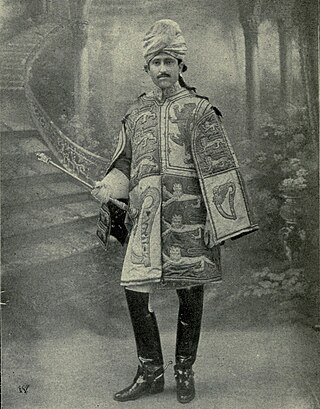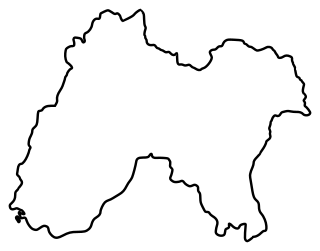
Sir Malik Khizar Hayat TiwanaKCSI, OBE was an Indian statesman, landowner, army officer, politician belonging to the Punjab Unionist Party. He served as the prime minister of the Punjab Province of British India between 1942 and 1947. He opposed the Partition of India and the ideology of Muslim League. He was eventually ousted from office by the Muslim League through a civil disobedience campaign, plunging Punjab into communal violence that led to the partition of the province between India and Pakistan.
The National Unionist Party was a political party based in the Punjab Province during the period of British rule in India. The Unionist Party mainly represented the interests of the landed gentry and landlords of Punjab, which included Muslims, Hindus and Sikhs. The Unionists dominated the political scene in Punjab from World War I to the independence of India and the creation Pakistan after the partition of the province in 1947. The party's leaders served as Prime Minister of the Punjab. The creed of the Unionist Party emphasized: "Dominion Status and a United Democratic federal constitution for India as a whole".
Alawalpur is a town and a municipal council in Jalandhar district in the state of Punjab, India. Alawalpur is named after Alawal Khan, a Pathan who ruled the area during the time of Maharajah Ranjit Singh. Sardar Himmat Singh Jallewalia, a Bains Jat Sardar, a general in Ranjit Singh's army, later conquered Alawalpur. His descendants still live in a fort located at the center of the city.
Shahpur District was a district in what is now Pakistan from 1893, during the British Raj, till 1960. From 1893 to 1914 Shahpur was the district headquarters. In 1914 the district headquarters were moved from Shahpur to Sargodha, although the district continued to be known as Shahpur. In 1960 the Sargodha District was created and Shahpur District became Shahpur Tehsil.

Major General Nawab Sir Umar Hayat Khan Tiwana, was a soldier of the Indian Empire, one of the largest landholders in the Punjab, and an elected member of the Council of State of India.
Mian Mumtaz Daulatana, was a Pakistani politician and a key supporter of Pakistan Movement in British India. After independence, he served as the second Chief Minister of West Punjab in Pakistan.
Khan Sahib, Qazi Zafar Hussain came from a qadi's family which had, since the 16th century, been prominent among the landed aristocracy of the Soon Valley. He belonged to Awans tribe of ancient repute. He was awarded the title of Khan Sahib by the British Crown. This was a formal title, a compound of khan (leader) and sahib (Lord), which was conferred in Mughal Empire and British India. Although his father, Qazi Mian Muhammad Amjad forbade his descendants to establish Dargah, he was considered Sajjada Nashin by the people of his area. "Sajjada nashins" David Gilmartin asserts, "claimed to be the descendants of the Sufi, 'saints', intermediaries between the Faithful and their God, and this cut against the grain of Islamic orthodoxy ... in kind, of their special religious status, these sajjada nashins had become men of local standing in their own right." However he never claimed to be a Sajjada Nashin. In the Punjab, the sajjada nashin or pir families were not so rich in terms of land as the great land lords of Punjab but these sajjada nashin or pir families exerted great political and religious influence over the people. The British could not administer the area without their help and no political party could win the election without their help.

When the All-India Muslim League was founded at Dacca, on 30 December 1906 at the occasion of the annual All India Muhammadan Educational Conference, It was participated by the Muslim leaders from Punjab, i.e., Sir Mian Muhammad Shafi, Mian Fazl-i-Hussain, Abdul Aziz, Khawaja Yusuf Shah and Sh. Ghulam Sadiq. Earlier Mian Muhammad Shafi organised a Muslim Association in early 1906, but when the All-India Muslim League was formed, he established its powerful branch in the Punjab of which he became the general secretary. Shah Din was elected as its first president. This branch, organised in November 1907, was known as the Punjab Provincial Muslim League.
Qazi Mazhar Qayyum 'Raees-Azam Naushera', is a Pakistani politician. He came from a qadi's family that had been prominent among the landed aristocracy of the Soon Valley since the 16th century.

Jhawarian is a town located near the Jhelum River in the District Sargodha, Tehsil Shahpur, Punjab, Pakistan.
Samthar State was a princely state in India during the British Raj. The state was administered as part of the Bundelkhand Agency of Central India. The state was ruled by Gurjars and was entitled to a 11 gun salute. Its capital, known then as Samshergarh, is located in a level plain in the Bundelkhand region crossed by the Pahuj and the Betwa Rivers.
Tiwana or Tawana is a widespread Punjabi tribe that claims both Jat and Rajput affiliation.
The Nawab of Mamdot was the title of the hereditary rulers of Mamdot, a princely state, near Firozpur, in the Punjab region of British India.
Malik Sahib Khan TiwanaCSI was a Punjabi Muslim Jatt landowner during the British India.
Malik Fateh Khan Tiwana was a Punjabi landowner and politician during the Sikh Empire.

Elections to the Punjab Provincial Assembly were held in January 1946 as part of the 1946 Indian provincial elections.

The Mian or miyan is a royal title of the Indian subcontinent, also sometimes used as a surname. Begum or Beygum, is used to describe the wife of a Mian. It is used by several monarchs of Indian states.

First Provincial assembly election was held in Punjab in the winter of 1936-37 as mandated by the Government of India Act 1935.





